- ● homepage
- ● archives
- ● restoration
- ● books
- ● big banners
- ● post board
- ■ neo's search
- ■ about us
- ■ 게재방법 안내
- 개인정보처리방침

- [email protected]
- Tel. 02_335_7922
- Fax. 02_335_7929
- 10:00am~04:30pm
- 월요일~금요일
- 3/3(월) 대체공휴일

색으로 춤추다 Eternal Beauty Series
이은주展 / Rachel Lee / 李恩周 / painting 2013_0522 ▶ 2013_0528
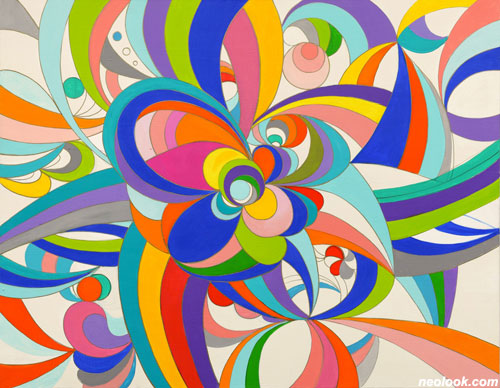
- 이은주_gravity_캔버스에 아크릴채색_91×117cm_2013
초대일시 / 2013_0522_수요일_05:00pm
관람시간 / 11:00am~07:00pm
57th 갤러리 서울 종로구 송현동 57번지 2층 Tel. +82.2.733.2657 www.57gallery.co.kr
춤추는 우주 ● 이은주(레이첼 리)의 작품에는 만물이 소생하는 봄의 기운이 있다. 거듭된 이어짐과 탈바꿈으로 이루어진 이 세계에서 고립된 형태나 칙칙한 색은 자리를 잡지 못한다. '색으로 춤추다'라는 전시부제의 작품들은 유연한 형태와 순도 높은 색으로 가득하다. 형태는 꼬리를 물고 끝없이 이어지며, 색채는 이어지는 형태에 생동감을 부여한다. 단파장에서 장파장에 이르는 색의 에너지는 그 추진체인 선과 함께 약동하는 흐름을 만든다. 가는 외곽선에 감싸인 색은 빛이 된다. 색은 명확히 계획되지 않은 방향으로 달려 나간 형(形)을 충만하게 채운다. 잔잔한 흐름을 넘어서 춤까지 추는 요소들은 소외감을 자아내는 회색빛 도시의 분위기에서 벗어나 있다. 이 세계에는 선적 진보와 물량주의적 축적의 결과물인 뻣뻣한 직선도 발견되지 않는다. 반복적 형태도 없다. 상하와 좌우가 따로 없는 이 작품들은 중력으로부터도 자유롭다. 춤추는 색 띠는 뫼비우스 띠처럼 안과 밖의 경계도 무너뜨린다. 색의 띠는 다른 것과 유연하게 결합하기 위해 휘어져 있으며, 다음으로 이어질 운동을 준비한다. ● 이은주의 작품에서 사라짐 역시 이어짐의 또 다른 양상이다. 순도 높은 색이 모두 동원되었지만, 부딪힘 없이 평화롭게 공존한다. 거기에는 우리나라 정치권에서 발견되는 눈이 따가운 원색 풍경처럼, 본질적으로 비슷한 부류이기에 상대와 차이나는 선명한 색으로 자신을 도색할 필요가 없다. 여기에서는 모두 자기만의 색을 가지고 있기에, 한 줄로 서서 뒤따라야 할 길 같은 것은 정해져 있지 않다. 그곳은 자율이 자유와 자연스럽게 연관되는 이상적 세계이다. 색과 형태는 가느다란 선에 에워싸여 있지만, 그것은 고립과 단절이 아니라, 공존과 조화를 위한 장치이다. 그것은 각자가 될 수 없다면, 결코 하나도 될 수 없는 다원적 우주이다. 다원적 우주에 대한 명백한 상징은 무지개일 것이다. 흑이냐 백이냐, 또는 1이냐 0이냐 라는 양단간의 선택만을 강요하면서 전진해온 현실 세계는 이 무지개빛 세계를 극복해야만 할 유아기의 환상으로 치부했다.
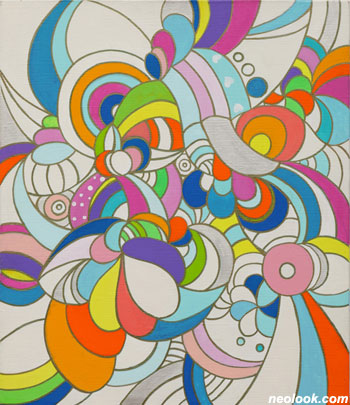
- 이은주_new spring_캔버스에 아크릴채색_53×45.5cm_2013
흑/백, 그리고 그것의 변주인 무채색은 생산과 진보, 의식과 형식, 심각함과 공식성, 깊이와 금욕 등을 상징하며, 이 침울한 현실 세계를 재처럼 뒤덮는다. 이러한 세계에서 살아있음이란 진정한 차이의 표시일 것이다. 불현 듯 떠오른 영감처럼, 어디선가 살짝 불어오는 바람은 잿빛 표면의 이면을 언뜻 보여 주는데, 그것은 태양아래 빛나는 세상의 진정한 주인인 무지개빛이다. 이은주의 작품에 현실이 담겨있다면, 그것은 무채색 현실도 무지개빛으로 가득 찼으면 하는 바램일 것이다. 강한 희망은 현실이 될 수 있다. 그것이 종교와 마찬가지로, 예술이 현실과 맺는 강렬한 방식이다. 이 원초적인 힘에 순응하는 작가는 작품 제목에 빠지지 않는 「영원한 아름다움...」을 지향한다. 상투적으로 보이는 두 단어의 조합에도 불구하고, 아름다움이 영원히 지속될 것을 원치 않는 사람이 있을까? 그러나 이러한 인류 보편적인 가치는 이루기 힘든 것이어서 그런지, 쉽게 괄호쳐지고, 심지어는 현실을 기만하는 부정의 대상이 되기도 한다. 사막이 현실이 되고, 오아시스를 환상으로 치부하는 격이다. ● 사실을 말하자면, 세계시장주의를 지배하는 자본만이 인간의 규칙을 넘어 자연의 법칙에 버금가는 무엇이 되어 무늬만 다원주의인 세계를 연출한다. 일찌기 코스모폴리탄이었던 이은주는 다양성의 진정한 모델인 자연과 예술(그리고 예술보다 더 긴 전통을 가지는 민속공예)에 매혹된다. 미술의 자기동일성을 향한 현대미술의 무거운 발걸음은 저 뒤편에 남겨두었다. 교조주의로 빠지기 쉬운 예술에 대한 형이상학은 몸의 언어와 밀접한 신비주의에 자리를 물려주었다. 지금도 외국인 남편과 국립국악원의 공연을 즐기는 작가의 작업실 책상에는 한국의 춤 전통에 대한 두터운 책자가 놓여있다. 이은주의 작품에는 자연 및 자연에 순응하여 살아온 민속적 전통에 보편적인 때깔—가령, 단청이나 색동, 그리고 여타의 이국적인 무늬들에 고유한 활력—이 있다. 이 보편적인 미의식은 또 하나의 보편적 가치인 사랑을 표현하기에 적합하다. ● 화사하면서도 약동하는 세계는 생물학적이 아니라, 정신적으로 맞은 새로운 인생의 봄과 관련된다. 세계 여기저기를 떠돌아다니며 살아왔던 20대를 보내고, 30대도 지나가려는 즈음, 작가는 '순간적인 깨달음처럼 인생의 봄'을 표현하고자 했다. 꽃과 나비, 꿈같은 것은 봄을 상징한다. 장자의 글귀가 연상되는 작품 「dream of butterfly」는 살짝 앉은 나비가 어떤 내부를 감싸고 있는지 모호한 색 띠 뭉치를 한 떨기 꽃으로 간주하게 한다. 그것은 꽃처럼 빈 중심에서 밖으로 뻗어나가면서 회귀하며, 처음과 끝을 알 수 없는 흐름을 이룬다. 다른 작품에 비해 미색이 더 많이 들어있는 작품 「eternal beauty_new spring」은 춤추는 색의 띠가 무채색--이은주의 작품에서 주조를 이루는 원색과 대조되는 미색은 흰색으로부터 시작된 것이다--허공을 차츰 뒤덮어간 것이라는 점을 알려준다. 그러나 이러한 뒤덮음은 공간공포증적인 것이라기보다는, 끝없이 이어지는 생성과 관련된다.
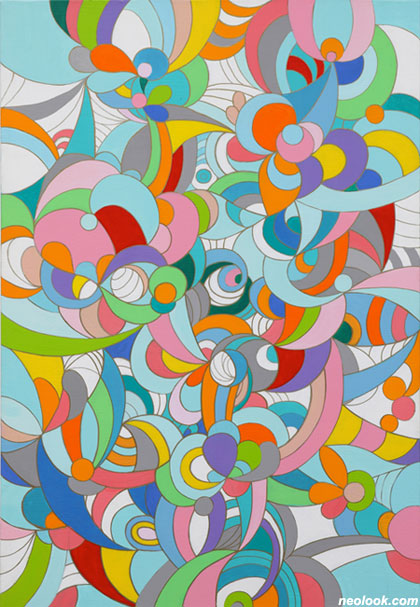
- 이은주_blossom_캔버스에 아크릴채색_117×80.5cm_2013
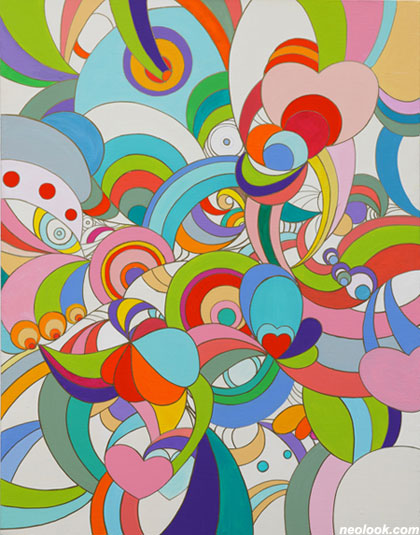
- 이은주_pray_캔버스에 아크릴채색_117×91cm_2013
하트 문양이 들어있는 그것은 작품 「eternal beauty_pray」와 더불어, 만물이 생성하는 봄과 피어오르는 사랑을 중첩시킨다. 이은주에게 봄, 또는 인생의 봄은 무엇보다도 사랑이다. 봄과 사랑은 영원한 발생의 상태라는 점에서 닮아 있다. 발생하고 성장하고 연결되며 하트 모양으로 열매를 맺는 그녀의 작품은 사랑의 이미지라고 말할 수 있다. 작은 원들이 화면 곳곳에 뿌려있고, 상호적인 연결선을 이루는 작품 「eternal beauty_ blossom」에서 언뜻언뜻 보이는 하얀 면은 밑바탕이기보다 다른 색과 동등한 요소로 참여한다. 여기에서는 현대물리학의 가설처럼, 공간도 물리적 사건의 주인공이 됨을 보여준다. 그것은 배경/형태라는 이원적 관계라기보다는 부드럽게. 또는 거세게 이어지는 하나의 흐름이다. 작품 「eternal beauty_metamorphosis」에서 흩어진 중심들을 이어주는 색 띠는 더욱 강력하다. 큰 규모의 작품에는 좀 더 큰 몸의 움직임이 드러난다. ● 작가는 작품을 시작할 때 미리 그려놓은 드로잉 없이 폭발적으로 진행한다. 거의 퍼포먼스처럼 나아가던 작업을 나중에 다듬고 정리한다. 아름다운 색만을 사용하면서 조화를 이루려면, 색칠에는 좀 더 계산적인 요소가 따른다. 작품 「eternal beauty_ mythology」에서 같은 크기의 캔버스는 모듈이 되어 벽면으로 확장된다. 이은주의 작품에서 색을 춤추게 하는 힘은 구성에 있다. 거기에는 점과 점이 만나서 선을 이루고, 우연과 필연이 복합되어 꽃을 피우는 듯한 방식이 있다. 마치 만(卍)자처럼 움직이는 점에서 사방으로 펼쳐지는 모양이 바로 춤인 것이다. 한 점에서 끊기 지 않고 곡선을 그리다 보니까, 이 유기적 연결 형태는 꽃 모양이 되었지만, 꽃이라는 구체적 도상과는 거리가 있다. 그것은 꽃이라는 자연의 외관보다는 우주의 본성을 표현한 것에 가깝다. 이 우주로서의 꽃에는 세상을 번성하게 하는 힘이 있으며, 보이지 않는 중심에 비밀을 품고 있다. ● 소우주로서의 꽃이 기하학적 형태를 갖춘다면 만다라가 될 것인데, 이은주의 작품은 그것이 풀려나가는 듯한 모습이 있다. 선의 흐름은 형태이자 궤적인 것이다. 하나의 중심으로 조여진 세계가 확장되면서 발생하는 에너지가 작품의 활력을 만들어낸다. 물론 그것은 작가가 '차가운 붉은 색'이라는 슬픈 대사가 나오는 서편제의 예를 든 것처럼, 죽음과 가까워지는 과정이기도 하다. 그것은 몸에서 벌어지는 사건과도 유사하다. 작가는 우주의 에너지와 교우하는 요가의 요법에 오랫동안 몰두해 왔다. 요가를 계속하면서 몸과 마음을 일치시켰다. 요가의 경험은 스스로가 건강하고 깨어있을 때 에너지가 형성된다는 깨달음을 주었다. 요가는 나무 포즈를 취하면 내가 아닌 나무가 될 수 있도록 한다. 되기는 현실성보다는 잠재성에 방점을 찍는 것이고, 그것은 변화무쌍한 선과 색의 흐름으로 이루어진 작품에 나타난다. 작가는 전 우주에 기도를 하는 힌두교는 우리의 민속신앙과도 닮았다고 말한다. 여기에서 고립된 존재는 없다. 만물은 존재가 아닌 되기를 통해 엮여진다.
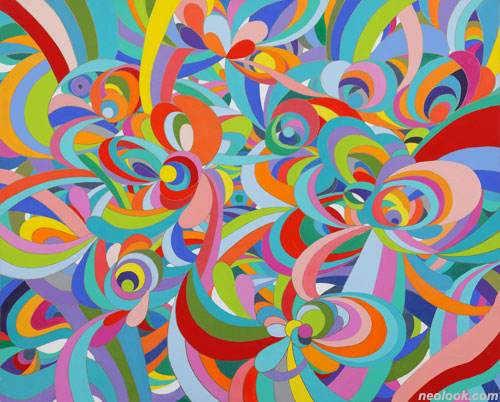
- 이은주_Metamorphosis_캔버스에 아크릴채색_130.5×162cm_2013
작가는 '나는 내 몸으로 신이 보여주는 것을 만드는 사람에 불과하다'고 말하는 동남아 민속 공예가의 말을 기억한다. 작가 또한 자신의 심신을 관통하는 힘을 표현하는 매개자에 불과한 것이다. 이은주의 작품은 만물의 영장, 사물의 보편적 척도가 되려는 서구중심의 인간론이 아니라, 우주자체가 기준이 된다. 그녀에게 우주는 거대한 차원을 가지지 않는다. 한 송이 꽃에 우주가 있고, 그것들이 피고 지는 것에 우주의 원리가 있다. 꽃으로부터 출발한 상징적 우주는 자연을 앞세우며 서구문명에 도전했던 1960년대 청년들의 플라워 파워(flower power)를 떠오르게 한다. 히피문화의 포스터를 장식했던 알록달록한 색의 흐름은 이은주의 작품과 마찬가지로 단순한 무늬를 넘어서 대안의 세계관을 제시했기 때문이다. 꽃-몸-우주가 교차되는 유기체적 곡선에는 경쟁과 전쟁을 지향하는 경직된 문명을 대신하는 자유와 평화에의 갈구가 있다. 또한 술이나 향수, 환각제의 재료가 되었던 식물은 도취적인 아름다움과 관련된다. 고정됨 없는 움직임의 세계는 환상적으로 다가온다. 거기에는 고정된 현실원리를 대체하는 쾌락원리가 지배한다. ● 그것은 지금 여기의 현실로부터 여행을 떠나게 한다. 이은주는 비행기로 떠나는 여행 못지않게 예술을 통해 정신의 여행(trip)을 떠난다. 물론 정신의 여행 또한 작가가 몰두하는 요가처럼 몸이 배제되지 않는다. 요동치는 형태와 자극적인 색깔은 기성의 언어와 형식, 기호 등으로부터 탈주하며, 개념화로 지친 현대미술의 어법에 몸의 감수성을 복권시킨다. 이원론이 지배하는 세계에서 몸은 다분히 도구적인 역할만을 부여받아, 기계적인 노동이나 쾌락적 소비와 연관된 마케팅의 대상이 되었을 뿐이었다. 몸은 다시금 자연과 근본적인 연결을 꾀한다는 점에서, 발랄하면서도 다소 느긋해 보이는 이은주의 작품에는 우회적인 문명비판이 있다. 거기에는 우울과 침체, 무기력을 낳는 억압적 힘이 제거되었을 때 튕겨 나와 발산되는 에너지가 있다. 그녀의 작품은 세계대전 전야에 종말론을 직감했던 초기 추상 화가들을 고무시켰던 것과 같은, 자율적 색과 형태에 대한 강한 긍정이 발견된다. 그것은 모순과 질곡에 가득한 세상을 단순히 재현하는데 그치지 않는 회화의 가능성이다.
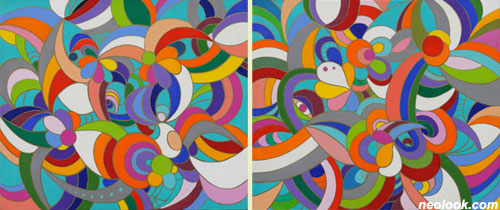
- 이은주_mythology I_캔버스에 아크릴채색_45.4×53_2013 이은주_mythology II_캔버스에 아크릴채색_45.4×53cm_2013
이러한 경향은 원래부터 추상예술인 음악과 춤, 그리고 정신의 세계에서도 발견될 수 있다. 비극적 세계로부터의 도피나 도약의 필연성은 낭만주의 시대나 모더니즘 시대나 지금이나 여전하다. 칸딘스키나 몬드리안 등, 추상회화의 선구자들은 추상의 언어로 엄밀한 상징적 의미가 있는 대안의 세계를 건설하였으며, 곧 근대회화의 진보는 세계 시장화처럼 동질적 세계로 귀결되었다. 그러나 몸은 결코 하나의 차원만을 인정하지 않는다. 일상적 경험에서, 특히 세계를 돌아다닐 때 차이의 표시가 가장 확연한 것은 바로 몸이다. 몸은 동질적 우주에 이질성을 도입한다. 항상성만을 중시하는 보수적 입장에서, 이질성은 질병의 요소로 간주될 수 있다. 그러나 이질성이 없다면 변화는 불가능하다. 변화의 현상형태가 바로 다채로움이다. 이 다채로움이 평화를 낳는다. 그렇기에 예술가들은 대체로 평화주의자이다. 진정한 다원성의 조건이 부재한 곳에서 강한 진리는 있을지 모르지만, 아름다움과 신비로움은 없을 것이다. ● 비트겐슈타인에 의하면 지혜는 회색빛이다. 그러나 삶과 종교는 색깔이 풍부하다. 신이란 자연계의 무한성을 닮는다. 형식적 측면에서 이은주의 작품은 어디에나 중심을 가지는 편재(omnipresence) 성이 특징이다. 그 또한 신비로운 체험을 낳으며 근본적으로는 종교적이다. 종교학자 니니안 스마트는 「비교 종교학」에서 신비경험은 순수의식, 개인의 해탈이 중요하다고 말한다. 그에 의하면 거룩한 요가 승들은 수행과정을 통해서 일상적인 대상으로서의 세계가 사라지는 초탈과 평정의 상태에 도달한다. 진정한 정적의 상태에 도달한 사람을 일상세계로 돌아올 수 있으며, 사물과 사람들을 새로운 시각에서 이해할 수 있다는 것이다. 그것은 세계와 하나 되는 만유재일적(panenhenic) 체험이다. 요가 수행자들에게 주체와 객체 사이의 구분은 의식의 높은 단계에서 소멸한다. 동양의 불이(不二), 서양의 숭고(sublime)는 강렬한 종교적 경험이자 미적 경험이다. 현대 예술은 이와 같은 보다 근본적 경험과 상호작용할 수 있어야 한다. ● 이 대양(大洋)적 만남에서 예술의 오랜 짝인 자연은 그 단초가 될 수 있을 것이다. 인간이 자연에 저질러 놓은 죄 때문에 위험에 빠져 경직된 문명은 자연의 힘으로 느슨해지고 생명을 고양시키는 힘으로 갱신되어야 한다. 갱신을 죽음을 두려워하지 않는다. 죽음을 두려워하지 않는 쾌락은 열락(jouissance)이다. 역사의 끄트머리에서 신화로의 복귀가 이루어지고, 원점으로의 복귀는 새로운 시작을 위한 근본적인 여행이다. 만물의 영장으로서의 인간, 편협한 자기중심주의는 부드럽지만 강력한 흐름에 그 취약한 경계선을 흩어트린다. 복잡하게 꼬여 있는 듯 하지만 풀면 풀릴 수 있을 것 같은 다채로운 색 띠로 만들어진 이은주의 곡선의 우주는 쏜살같은 시간이 아닌, 샘솟는 시간을 예시한다. 색과 형태의 끝없는 유출은 무덤덤하게 흐르는 기계적 시간을 환상의 시간으로 도약시킨다. 추상적 이성과 노동의 세계를 지배하는 시점과 종점을 가지는 선적 시간과 달리, 샘솟는 시간은 강렬한 현재로의 회귀를 촉구한다. 그리고 회귀는 영원히 계속된다. 그것은 그토록 많은 문화에서 발견되는, 영원 회귀하는 순환적 시간이다. ■ 이선영
The Dancing Universe ● Rachel Lee's work bears a spring mood in which all living things come to life. In this world composed of consistent continuation and metamorphoses, isolated forms and dull colors have no position to settle. The work titled Dancing with Colors is full of flexible forms and high-purity hues. Forms are endlessly connected, and colors lend vitality to forms. Colors with energy ranging from short wavelength to long wavelength generate a lively stream alongside lines. The colors encircled with thin outlines become light. Apparently not planned, the colors repletely fill forms spreading toward the orientation. The elements dancing beyond a tranquil flow are far away from the atmosphere of a grayish city exuding a sense of alienation. No linear progress, stiff straight lines, and repetitive forms are discovered in this world. These works which do not rely on the distinction between top and bottom or left and right are free from gravity. Dancing color strips break down the boundary between inside and outside like the Mobius strip. The color strips are bent to combine with others flexibly, preparing the movement to link to others. ● Disappearing is another aspect of being connected in Rachel Lee's work. Colors with high purity adopted for her work coexist in peace. As all colors appear essentially similar, no need to employ vivid colors exists. All her works have their own colors with no set patterns or ways. Her work is an ideal world related naturally to autonomy and liberty. Colors and forms encircled with thin lines do not remain in isolation and severance but are devices for coexistence and harmony. Her world is the pluralistic universe that can never be one. The rainbow is an apparent metaphor for this pluralistic universe. The realistic world in which people are forced to choose between two extremes--black or white, one or zero--regards this rainbow as a childhood fantasy to be overcome. ● Achromatic colors are symbolic of production and progress, ritual (consciousness) and form, seriousness and officiality, and depth and abstinence, veiling this gloomy realistic world like an ash. A true difference is represented with the fact one lives in this world. Like an inspiration occurring all of a sudden, a slightly blowing breeze unveils the hidden side of the gray surface. This is the rainbow light, a real master of a brilliant world under the sun. If Lee's work encapsulates reality, her work represents her wish to fill an achromatic reality with rainbow colors. A strong hope can be reality. This is an intense force with which art has a connection with reality as in religion. Lee adapting herself to this primal force pursues "eternal beauty" which she adopts as the title of all her works. Despite the combination of these two seemingly hackneyed words, is there anyone who does not want eternally sustained beauty? However, this universal value of mankind is often denied or even becomes a negative object deceiving reality because it is so hard to attain. This, like a desert, becomes reality, and an oasis becomes regarded as a fantasy. ● Only capital dominating the principle of free markets generates a pseudo-plural world, extending beyond human rules. A cosmopolitan Rachel Lee has been captivated by nature and art (and folkcraft with longer tradition than art). She puts behind heavy contemporary art seeking self-identity. Metaphysics of art that tends to fall into dogmatism made way for occultism related closely to body language. Lee still enjoys traditional Korean music performances at the National Gukak Center with her foreigner husband. Placed on the desk at her studio is a bulky book on Korean dance tradition. Lee's work displays hues (like dancheong, or multi-colors applied to a wooden building, and saekdong, or the stripes of rainbow colors applied to a garment) common to folk tradition in which Koreans lived adapting themselves to nature. Her work also exhibits liveliness indigenous to exotic patterns. This universal aesthetic sense is also appropriate for expressing love, another universal value. ● A brilliant, salutatory world is associated with a new spring in life that we greet spiritually, not biologically. Lee wandered around the world in her 20s and into her late 30s. At this juncture, she intends to represent "the spring of her life like a momentary enlightenment." Elements such as a flower, butterfly, and dream symbolize spring. In her work The Butterfly Dream, reminiscent of Zhuangzi's butterfly dream, a bundle of color bands is considered a flower with a butterfly sitting gently. Like a flower, the bundle spreads from an empty center to the outside and then returns, forming a flow without beginning or end. In Eternal Beauty_New Spring, applied with more ivory than other pieces, dancing color strips gradually cover an achromatic space. This covering is related to endlessly consecutive creation. ● As in Eternal Beauty_Pray, this work with the heart shape overlaps spring when everything is fresh and vivid with blossoming love. For Lee, spring, or the spring of life, is above all love. Spring is akin to love in that both are in a state of eternal generation. Images generating, growing, and bearing heart-shape fruit in her work can be seen as love images. In Eternal Beauty_Blossom, in which tiny circles are seen everywhere in the canvas, white planes sporadically join her work equally with other hues. This work shows that space can be a protagonist of a physical incident like a hypothesis in contemporary physics. This is not a dichotomous relation between background and form but a consistently connected flow. In Eternal Beauty_ metamorphosis, color strips connecting dispersed centers appear more powerful. A more conspicuous movement of the body appears in larger scale works. ● Lee executes her work explosively without prior sketches. Her work conducted like a performance is polished and arranged later. Applying colors has to be more calculative if harmony is to be generated by using only beautiful hues. In Eternal Beauty_Mythology, canvases of the same size become modules extending to a wall. The strength of making colors dance in Lee's work is composition. The composition is composed of ways in which lines are formed when dots meet, and flowers bloom when necessity and change are fused. A shape spreading in all directions from dots moving like the swastika symbol is none other than a dance. Curves are rendered with connected dots, and this organic connection forms a flower, but this flower is away from a concrete image. This is closer to a representation of the true nature of the universe than an outer appearance of nature like the flower. The flower has the force flourishing the world and bears a secret in its invisible center. ● If the flower as a microscope was in a geometric form, it would be a mandala. Lee's work hints at a released form of the mandala. The flow of lines is form and trajectory. Her work becomes enlivened with the energy generated when the condensed world expands. As the artist gives an example of "cold, red color" taken from the film Seopyeonje, it is a process of drawing near death. This is similar to an accident happening in the body. The art has long been immersed in yoga therapy befriending cosmic energy. She has coincided her body with her mind through yoga. She found enlightenment knowing that energy is formed when she remains healthy and awakened through yoga. A tree pose makes her become a tree, not herself. Becoming is not reality but potential. This aspect is represented with the flow of ever-changing lines and colors in her work. The artist alludes that Hinduism praying for the whole universe is akin to Korean folk religion. No beings are isolated here. All things are entangled through becoming, not existence. ● The artist remembers what a Southeast Asian craft artist stated: "I am nothing but one who fabricates what god shows with my body." The artist is also nothing but a mediator representing the force penetrating her body and mind. Lee's work does not rely on the Western view of man where man is the lord of all creation and the universal measure of all things but sees the universe itself as the criterion. For the artist, the universe has no immense dimension. ● The universe is in a flower, and its principle is in a phenomenon where the flower blooms and fall. The symbolic universe derived from the flower reminds viewers of the "flower power" of the 1960s when young people challenged Western culture. The flow of mottled colors in the posters of hippy culture presents an alternative view of the world, moving beyond a simple pattern, as Lee's work did. Rachel Lee represents a thirst for freedom and peace to replace a stiff civilization seeking competition and war through her organic curves in which the flower, the body, and the universe intersect. Plants that were materials for liquor, perfume, or hallucinogen are associated with masturbatory beauty. The world of movement without calm comes fantastically alive, governed by the principle of pleasure replacing the principle of reality. ● This makes one leave reality. Lee goes on a spiritual trip through art. Her spiritual journey does not also exclude her body as she did in yoga. Jolting forms and pungent colors escape from pre-existing language, mode, and symbol, rehabilitating the body's sensibility in contemporary art idioms. In the world dominated by dualism, the body was nothing but the object of marketing related to mechanic labor or pleasurable consumption, merely regarded as a device. The body tries to have an underlying connection with nature. In this sense, Lee's lively yet relaxed work implies an indirect criticism of civilization. Her work energy is aroused when the oppressive force that causes depression, withdrawal, and lethargy is removed. A strong affirmation of autonomous color and form is discovered in her work as encouraged by early abstract artists on the eve of the World War. This is possible through paintings that transcend a mere representation of the world full of contradiction and ordeal. ● This tendency is also found in music, dance, and the spiritual world. Leaping and escaping from a tragic world has been inevitably required in the age of romanticism and modernism as well as present times. The forerunners of abstract painting such as Wassily Kandinsky and Piet Mondrian built an alternative world with strict symbolic meaning in abstract language. As the world was globalizing into one market, modern painting progressed into a heterogeneous world. However, the body never admits one dimension. When traveling around the world, we may find there is a clear difference in all bodies. The body embraces heterogeneity in the homogeneous universe. This heterogeneity may be considered a sign of disease from a conservative perspective emphasizing only constancy. But, change is impossible without heterogeneity. The phenomenal form of change is diversity. It gives rise to peace. Therefore, artists are usually pacifists. Truth may exist in the place where diversity is missing but no beauty and mystery exists there. ● According to Ludwig Wittgenstein, wisdom is grayish, but life and religion are rich in color. God resembles the infinity of nature. In terms of form Lee's work is characterized by omnipresence. Fundamentally religious, her work also gives rise to mystic experience. Religion scholar Ninian Smart argues in Comparative Religion that pure consciousness and individual nirvana is of significance in mystic experience, adding that yoga monks reach a state of transcendence and composure in which the world as a daily object vanishes through a process of their asceticism. This means those who have reaches the state of a true composure cannot come back to their daily world and can understand things and people from a new perspective. This is panenhenic experience through which practitioners become one with the world. For Yoga practitioners the distinction between subject and object disappears in a high level of consciousness. Non-duality in the East and the sublime in the West are intense religious, aesthetic experience. Contemporary art has to interact with such more underlying experience. ● Nature, a complex dual art form might be the clue to this oceanic encounter. Stiff civilization failing in a perilous state due to humanity's crime against nature has to be renewed with the power of nature and the force encouraging life. Renewal does not fear death. Pleasure, unafraid of death is "jouissance". A return to mythology and the starting point at the end of history is a journey for a new start. ● Lee's curvilinear universe, made up of diverse color strips that seem intricately entangled but converts dully flowing mechanic time into fantastic time. Unlike lineal time with the point of beginning and end dominating the world of abstract reason and labor, surging time urges the return to the present. The return keeps going forever. This is cyclical time for an eternal returning found in many cultures. ■ Lee Sun-young
* Transrated by artntext.com
Vol.20130522b | 이은주展 / Rachel Lee / 李恩周 / painting
